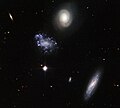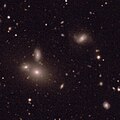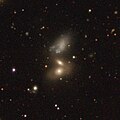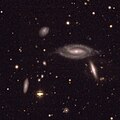| Image | HCG | Right ascension [3] | Declination [3] | Galaxy count [4] | Members | Notes |
|---|
 | 1 | 00h 26.0m | +25° 43′ | 4 | UGC 248, PGC 1625, PGC 1614, PGC 1618 | In Andromeda, westnorthwest of HD 2315 |
 | 2 | 00h 31m 24s | +08° 26.8′ | 4 | UGC 312, Markarian 552, UGC 314, UGC 315 | In Pisces, east of HD 2679 |
 | 3 | 00h 34m 11s | −07° 35.6′ | 4 | MCG-01-02-032, PGC 2064, PGC 2059, PGC 2043 | In Cetus, less than 1 degree north of NGC 157 |
 | 4 | 00h 34m 15.3s | −21° 26′ 52″ | 5 | ESO 540-1, ESO 540-2, PGC 2051, PGC 2057, PGC 2040 | In Cetus |
 | 5 | 00h 38m 54s | +07° 03.8′ | 4 | NGC 190, NGC 190S, MCG+01-02-042, PGC 2326 | In Pisces |
 | 6 | 00h 39m 10s | −08° 23.7′ | 4 | PGC 2347, PGC 2350, PGC 2351, PGC 2353 | In Cetus, south of the asterism Pointer made of HD 3841, HD 3821, HD 3770, HD 3733, and HD 3707 |
 | 7 | 00h 39m 15.9s | +00° 53′ 17″ | 4 | NGC 192, NGC 196, NGC 197, NGC 201 | In Cetus, contains three spirals and one lenticular galaxy [5] |
 | 8 | 00h 49m 37s | +23° 34.8′ | 4 | MCG+04-03-008, PGC 2888, PGC 2890, PGC 2892 | In Andromeda |
 | 9 | 00h 54m 18s | −23° 33.1′ | 4 | MCG-04-03-027, MCG-04-03-028, PGC 3196, PGC 3200 | In Cetus |
 | 10 | 01h 26m 24.5s | +34° 42′ 51″ | 4 | NGC 536, NGC 529, NGC 531, NGC 542 | In Andromeda |
 | 11 | 01h 26.6m | −23° 13′ | 4 | ESO 476-8, MCG-04-04-010, PGC 5357, PGC 5381 | In Cetus |
 | 12 | 01h 27m 33.7s | −04° 40′ 14″ | 5 | MCG-01-04-052, PGC 5432, PGC 5439, PGC 5443, PGC 5445 | In Cetus |
 | 13 | 01h 32.4m | −07° 52′ | 5 | MCG-01-05-002, MCG-01-05-003, MCG-01-05-004, PGC 5728, PGC 5741 | In Cetus |
 | 14 | 01h 59m 47s | −07° 01.7′ | 4 | MCG-01-06-017, MCG-01-06-019, MCG-01-06-020, MCG-01-06-022 | In Cetus |
 | 15 | 02h 07m 39.0s | +02° 08′ 18″ | 6 | UGC 1617, UGC 1618, UGC 1618 B, UGC 1620, UGC 1624, MCG+00-06-033 | In Cetus |
 | 16 | 02h 09m 31.3s | −10° 09′ 31″ | 4 | NGC 835, NGC 833, NGC 838, NGC 839 | In Cetus. Contains three starburst galaxies, two LINER galaxies, and a Seyfert 2 galaxy [6] |
 | 17 | 02h 14m 04.5s | +13° 18′ 54″ | 5 | PGC 8558, PGC 8559, PGC 8560, PGC 8561, PGC 8564 | In Aries |
 | 18 | 02h 39m 06.10s | +18° 23′ 02.0″ | 4 | MCG+03-07-038, UGC 2140 | In Aries |
 | 19 | 02h 42m 45s | −12° 24.7′ | 4 | MCG-02-07-073, MCG-02-07-074, MCG-02-07-075, PGC 10269 | In Cetus |
| 20 | 02h 44m 14s | +26° 06.2′ | 6 | PGC 10364, PGC 10365, PGC 10366, PGC 10367, PGC 10368, PGC 10369 | In Aries |
 | 21 | 02h 45m 16.9s | −17° 37′ 35″ | 5 | NGC 1099, NGC 1100, NGC 1098, NGC 1091, NGC 1092 | In Eridanus |
 | 22 | 03h 03m 31s | −15° 40.5′ | 5 | NGC 1199, NGC 1190, NGC 1189, NGC 1191, NGC 1192 | In Eridanus |
 | 23 | 03h 07m 06s | −09° 35.1′ | 5 | NGC 1214, NGC 1215, NGC 1216, MCG-02-08-054 | In Eridanus |
 | 24 | 03h 20.3m | −10° 51′ | 5 | MCG-02-09-031, MCG-02-09-032, PGC 12472, PGC 12492, PGC 12489 | In Eridanus |
 | 25 | 03h 20m 43.7s | −01° 03′ 07″ | 7 | UGC 2690, UGC 2691, PGC 12524, PGC 12530, PGC 12533, PGC 12538, PGC 12550 | In Cetus |
 | 26 | 03h 21m 54s | −13° 38.8′ | 7 | MCG-02-09-035, HCG 26b, PGC 12604, PGC 12605, PGC 12610, PGC 12613, PGC 12615 | In Eridanus |
 | 27 | 04h 19.4m | −11° 42′ | 6 | PGC 14861, PGC 14862, PGC 14863, PGC 14866, PGC 14870, PGC 14873 | In Eridanus |
 | 28 | 04h 27m 19s | −10° 19.0′ | 4 | PGC 15135, PGC 15136, PGC 15141, HCGd 28d | In Eridanus |
 | 29 | 04h 34m 45s | −30° 32.8′ | 4 | PGC 15559, PGC 15560, PGC 15561, PGC 15562 | In Eridanus, immediately west of υ2 Eridani (Upsilon2 Eridani) |
 | 30 | 04h 36.5m | −02° 49′ | 4 | MCG+00-12-051, MCG+00-12-054, PGC 15624, PGC 15636 | In Eridanus |
 | 31 | 05h 01m 37s | −04° 15.4′ | 4 | NGC 1741A, PGC 16570, NGC 1741B, PGC 16571 | In Eridanus |
 | 32 | 05h 01.7m | −15° 25′ | 4 | MCG-03-13-053, PGC 16578, PGC 16584, PGC 16587 | In Lepus, westnorthwest of planetary nebula Abell 7, southeast of R Leporis (Hind's Crimson Star) |
| 33 | 05h 10m 47.6s | +18° 01′ 11″ | 4 | PGC 16863, PGC 16866, PGC 16867, PGC 16871 | In Taurus |
 | 34 | 05h 21m 47s | +06° 40.6′ | 4 | NGC 1875, VV 169b, VV 169c, VV 169d | In Orion, half a degree southsouthwest of Dolidze 17 (asterism Metronome) |
 | 35 | 08h 45m 20.71s | +44° 32′ 23.1″ | 6 | PGC 24596, PGC 24597, PGC 24598, PGC 24599, PGC 24600, PGC 24601 | In Lynx |
 | 36 | 09h 09m 24s | +15° 47.7′ | 4 | IC 528, IC 528C, PGC 25782, PGC 25791 | In Cancer |
 | 37 | 09h 13m 35.6s | +30° 00′ 51″ | 5 | NGC 2783, UGC 4856, MCG+05-22-016, MCG+05-22-018, MCG+05-22-020, | In Cancer |
 | 38 | 09h 27.6m | +12° 16′ | 4 | MCG+02-24-012, UGC 5044, MCG+02-24-014, PGC 26830 | In Leo |
 | 39 | 09h 29m 28s | −01° 20.7′ | 4 | PGC 26925, PGC 26926, PGC 26929, PGC 26931 | In Hydra |
 | 40 | 09h 38m 54s | −04° 51.1′ | 6 | MCG-01-25-008, MCG-01-25-009, MCG-01-25-010, MCG-01-25-011, MCG-01-25-012, PGC 27517 | In Hydra, also known as Arp 321 |
 | 41 | 09h 57m 40s | +45° 14.4′ | 4 | UGC 5345, UGC 5346, MCG+08-18-046, PGC 28784 | In Ursa Major |
 | 42 | 10h 00m 13.1s | −19° 38′ 24″ | 4 | NGC 3091, NGC 3096, MCG-03-26-006, PGC 28926 | In Hydra, also known as NGC 3091 Group |
 | 43 | 10h 11.2m | −00° 01′ | 6 | Z 8-59, Z 8-61, Z 8-62, PGC 29666, PGC 29668, PGC 29673 | In Sextans, less than one degree eastnortheast of α Sextantis (Alpha Sextantis) |
 | 44 | 10h 18m 00s | +21° 48.7′ | 4 | NGC 3185, NGC 3187, NGC 3190, NGC 3193 | In Leo |
 | 45 | 10h 19.2m | +59° 06′ | 4 | UGC 5564, PGC 30137, PGC 30143, PGC 30156 | In Ursa Major |
 | 46 | 10h 22.0m | +17° 48′ | 4 | MCG+03-27-005, MCG+03-27-007, MCG+03-27-008, MCG+03-27-009 | In Leo |
 | 47 | 10h 25m 48s | +13° 43.9′ | 4 | UGC 5644, MCG+02-27-013, MCG+02-27-014, MCG+02-27-015 | In Leo |
 | 48 | 10h 37m 45.6s | −27° 04′ 50″ | 4 | IC 2597, ESO 501-59, PGC 31577, PGC 31580 | In Hydra |
 | 49 | 10h 56m 36s | +67° 10.8′ | 4 | PGC 32890, PGC 32893, PGC 32895, PGC 32899 | In Ursa Major |
 | 50 | 11h 17m 06s | +54° 55.1′ | 5 | PGC 34444, PGC 34447, PGC 34448, PGC 34452, PGC 34453 | In Ursa Major, half a degree eastsoutheast of Messier 97 (Owl nebula) |
 | 51 | 11h 22m 21.6s | +24° 19′ 41″ | 7 | NGC 3651, NGC 3653, IC 2759, MCG+04-27-030, MCG+04-27-027, PGC 34899, PGC 34901 | In Leo |
 | 52 | 11h 26.3m | +21° 05′ | 4 | MCG+04-27-036, PGC 35178, PGC 35179, PGC 35184, | In Leo |
 | 53 | 11h 28m 58s | +20° 46.6′ | 4 | NGC 3697, Mrk 1296, MCG+04-27-044, PGC 35381 | In Leo |
 | 54 | 11h 29m 15s | +20° 34.7′ | 4 | IC 700 | In Leo |
 | 55 | 11h 32m 07s | +70° 48.7′ | 5 | PGC 35573, PGC 35574, PGC 35575, 2MASX J11320571+7048236, HCG 55e | In Draco, half a degree northwest of NGC 3735 |
 | 56 | 11h 32m 32s | +52° 56.9′ | 5 | MCG+09-19-113, Mrk 176, PGC 35609, PGC 35615, PGC 35618 | In Ursa Major, south of NGC 3718 and a popular target for amateur astronomers |
 | 57 | 11h 37m 50.5s | +21° 59′ 06″ | 8 | NGC 3753, NGC 3746, NGC 3750, NGC 3754, NGC 3748, NGC 3751, NGC 3745, PGC 36010 | In Leo, also known as Copeland Septet |
 | 58 | 11h 42m 09.4s | +10° 16′ 30″ | 5 | NGC 3817, NGC 3819, NGC 3820, NGC 3822, NGC 3825, | In Leo and Virgo |
 | 59 | 11h 48m 27s | +12° 43.0′ | 5 | IC 737, IC 736, PGC 36871, PGC 36867, PGC 36851 | In Leo |
 | 60 | 12h 03m 05s | +51° 41.6′ | 4 | MCG+09-20-071, PGC 38053, PGC 38064, PGC 38072 | In Ursa Major |
 | 61 | 12h 12m 24s | +29° 10.7′ | 4 | NGC 4169, NGC 4170, NGC 4174, NGC 4175 | In Coma Berenices, also known as Box galaxies |
 | 62 | 12h 53m 05.6s | −09° 12′ 21″ | 4 | NGC 4759, NGC 4761, NGC 4764, NGC 4776, NGC 4778 | In Virgo |
 | 63 | 13h 02.2m | −32° 46′ | 4 | ESO 381-50, ESO 443-37, PGC 44959, PGC 44979 | In Centaurus |
 | 64 | 13h 25m 43s | −03° 51.5′ | 4 | PGC 46971, PGC 46972, PGC 46975, PGC 46977, | In Virgo |
 | 65 | 13h 29m 53s | −29° 30.0′ | 5 | ESO 444-55, PGC 47401, PGC 47403, PGC 47406, PGC 47407 | In Hydra |
 | 66 | 13h 38m 33s | +57° 18.3′ | 4 | MCG+10-19-104, PGC 48220, PGC 48231, PGC 48222 | In Ursa Major |
 | 67 | 13h 49m 03.5s | −07° 12′ 20″ | 4 | NGC 5306, MCG-01-35-013, MCG-01-35-015, PGC 49036 | In Virgo |
 | 68 | 13h 53m 40.9s | +40° 19′ 07″ | 5 | NGC 5350, NGC 5353, NGC 5354, NGC 5355, NGC 5358 | In Canes Venatici |
 | 69 | 13h 55m 31s | +25° 03.8′ | 4 | UGC 8842, Z 132-48, MCG+04-33-028, PGC 49499 | In Bootes, HCG 69 is surrounded by other galaxies, such as IC 4343, IC 4344, IC 4345, IC 4346, IC 4348 and IC 4349 |
 | 70 | 14h 04m 07.4s | +33° 19′ 10″ | 7 | IC 4369, IC 4370, IC 4371, UGC 8990, MCG+06-31-057, MCG+06-31-065, PGC 50123 | In Canes Venatici |
 | 71 | 14h 11.1m | +25° 29′ | 4 | NGC 5008, IC 4382, PGC 50640, PGC 50641 | In Bootes |
 | 72 | 14h 47m 55s | +19° 03.6′ | 6 | UGC 9532, MCG+03-38-017, MCG+03-38-018, MCG+03-38-018, MCG+03-38-020, MCG+03-38-022 | In Bootes |
 | 73 | 15h 02m 40.1s | +23° 21′ 13″ | 5 | NGC 5829, IC 4526, PGC 53702, PGC 53703, PGC 53720 | In Bootes |
 | 74 | 15h 19m 28s | +20° 53.6′ | 5 | NGC 5910, MCG+04-36-036, PGC 54692, PGC 54694, PGC 54697 | In Serpens Caput |
 | 75 | 15h 21m 37.0s | +21° 10′ 50″ | 6 | PGC 54802, PGC 54803, PGC 54804, PGC 54818, PGC 54824, PGC 54827 | In Serpens Caput |
 | 76 | 15h 31.7m | +07° 18′ | 5 | NGC 5941, NGC 5942, NGC 5944, MCG+01-40-003, PGC 55313, PGC 55325 | In Serpens Caput |
 | 77 | 15h 49m 17s | +21° 49.7′ | 4 | UGC 10049, PGC 56121, PGC 56122, PGC 56125 | In Serpens Caput |
 | 78 | 15h 48.5m | +68° 12′ | 4 | UGC 10057, MCG+11-19-016, PGC 56086, PGC 56095 | In Draco |
 | 79 | 15h 59m 13s | +20° 45.1′ | 5 | NGC 6027, NGC 6027a, NGC 6027b, NGC 6027c, NGC 6027d, NGC 6027e (tidal tail of NGC 6027) | In Serpens Caput, also known as UGC 10116, VV 115, Seyfert's Sextet or Serpens Sextet. Contains 2 lenticular galaxies, 3 spiral galaxies (one barred spiral) and a tidal tail. |
 | 80 | 15h 59m 12s | +65° 13.6′ | 4 | PGC 56572, PGC 56577, PGC 56588, PGC 56590 | In Draco |
 | 81 | 16h 18m 13s | +12° 47.6′ | 4 | SDSS J161813.66+124811.2, PGC 57774, PGC 57777, PGC 57779 | In Hercules |
 | 82 | 16h 28m 22.1s | +32° 49′ 25″ | 4 | NGC 6161, NGC 6162, NGC 6163, PGC 58231 | In Hercules |
 | 83 | 16h 35m 40.9s | +06° 16′ 12″ | 5 | PGC 58559, PGC 58561, PGC 58562, PGC 58565, PGC 58569 | In Hercules |
 | 84 | 16h 44m 08s | +77° 50.2′ | 6 | PGC 58856, PGC 58861, PGC 58873, PGC 58877, PGC 58881, PGC 58884 | In Ursa Minor |
 | 85 | 18h 50m 22.3s | +73° 21′ 00″ | 4 | PGC 62476, PGC 62477, PGC 62478, PGC 62484, | In Draco |
 | 86 | 19h 51m 59.2s | −30° 49′ 34″ | 4 | ESO 461-7, MCG-05-47-001, MCG-05-47-002, MCG-05-47-003, | In Sagittarius |
 | 87 | 20h 48m 11s | −19° 50.4′ | 4 | ESO 597-36, PGC 65409, ESO 597-35, PGC 65414 | In Capricornus, one of the most compact groups, hosting two active galactic nuclei and a starburst among its three members, all of which show signs of interaction |
 | 88 | 20h 52.4m | −05° 45′ | 4 | NGC 6978, NGC 6976, NGC 6977, MCG-01-53-014 | In Aquarius |
 | 89 | 21h 20.2m | −03° 54′ | 4 | MCG-01-54-012, PGC 66574, PGC 66575, PGC 66580 | In Aquarius |
 | 90 | 22h 02m 06.3s | −31° 55′ 48″ | 4 | NGC 7173, NGC 7174, NGC 7176, and NGC 7172 | In Piscis Austrinus, also called NGC 7176 Group |
| 91 | 22h 09m 00.8s | −27° 47′ 36″ | 4 | NGC 7214, ESO 467-15, ESO 467-13, HCG 91d | In Piscis Austrinus, also called VV 700 Group |
 | 92 | 22h 35m 57.5s | +33° 57′ 36″ | 5 | NGC 7317, NGC 7318A, NGC 7318B, NGC 7319, NGC 7320C | In Pegasus, also called Stephan's Quintet, one galaxy of the fivesome, NGC 7320, is not part of the HCG but is a foreground galaxy in front of the other four galaxies in the HCG. When discovered, two of the galaxies in the grouping were considered to be one galaxy, NGC 7318. |
 | 93 | 23h 15m 12.2s | +18° 59′ 31″ | 5 | NGC 7547, NGC 7549, NGC 7550, NGC 7553, NGC 7558 | In Pegasus |
 | 94 | 23h 17m 16.5s | +18° 43′ 11″ | 7 | NGC 7578, UGC 12477, PGC 70936, PGC 70937, PGC 70939, PGC 70941, PGC 70943, | In Pegasus |
 | 95 | 23h 19m 32s | +09° 29.5′ | 4 | NGC 7609, MCG+01-59-046, PGC 71077, PGC 71080 | In Pegasus, also called Arp 150 Group and NGC 7609 Group |
 | 96 | 23h 27m 58s | +08° 46.4′ | 4 | NGC 7674, NGC 7674A, NGC 7675, PGC 71507 | In Pegasus, immediately north of HD 220965 |
 | 97 | 23h 47m 24.0s | −02° 19′ 08″ | 5 | IC 5351, IC 5352, IC 5356, IC 5357, IC 5359 | In Pisces, northnorthwest of 20 Piscium |
 | 98 | 23h 54.2m | +00° 22′ | 4 | NGC 7783, MCG+00-60-059, PGC 72810, NGC 7783 C | In Pisces. In 2019 a giant tidal tail and a large envelope was discovered around HCG 98 with the Wise Observatory [7] |
 | 99 | 00h 00m 43s | +28° 23.7′ | 4 | UGC 12897, UGC 12899, MCG+05-01-021, PGC 60, PGC 57 | In Pegasus, west of HD 224895 |
 | 100 | 00h 01.3m | +13° 07′ | 4 | NGC 7803, Mrk 934, MCG+02-01-009, MCG+02-01-010 | In Pegasus |
|





































































































